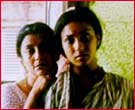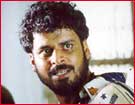Out of heart, out of mind!
Deepa Gahlot
Unless you are a frequent visitor to Calcutta or the film festival type, chances are you haven't seen the recent works of Rituparno Ghosh and Aparna Sen.
 I caught up with Sen's Paromitar Ek Din and Ghosh's Utsab and Bariwali at the recent Mumbai Film Festival.
I caught up with Sen's Paromitar Ek Din and Ghosh's Utsab and Bariwali at the recent Mumbai Film Festival.
And was bowled over once again. Sen's Yuganta and Ghosh's Unnishe April, Asookh and Dahan had already put them on the list of favourites.
Buddhadeb Dasgupta's Uttara did not arrive, but from all accounts, it is an impressive film.
It is clear that Sen and Ghosh are working with major budgetary constraints. All three films were shot in magnificent old Calcutta mansions -- stained glass, carved banisters, antique furniture and peeling plaster, all providing a glimpse into static lives struggling with ghosts of the past.
Because they have no money for gimmickry, both directors structure their scripts around relationships, write great dialogues, gently blend in music and ambient sounds to create evocative moments of beauty and emotional resonance.
Their films may not have attention-grabbing ingredients or technical polish, but they have stories to tell. Simple, unpretentious stories that come from the heart (and not just use the 'heart' as a catchline for a commercial potboiler like Mission Kashmir).
 Paromitar Ek Din tells of the friendship between a mother-in-law and daughter-in-law, Utsab about a troubled family trying to hold together, and Bariwali about a lonely woman exploited by a callous film crew.
Paromitar Ek Din tells of the friendship between a mother-in-law and daughter-in-law, Utsab about a troubled family trying to hold together, and Bariwali about a lonely woman exploited by a callous film crew.
Bengali stars like Prasenjit, Rituparna Sengupta and Indrani Haldar willingly star in these shoestring films.
Audiences in Bengal, still under the influence of (Satyajit) Ray and (Rabindranath) Tagore, are willing to see films that draw them in slowly with their identifiable stories and real characters rather than zap them with fast pace and techno-wizardry.
Filmmakers of the Bombay film industry have lost the art of storytelling -- maybe because they have nothing to share, no vision to communicate. Also, they function in an environment where it is not possible to deviate too much from the norm.
And audiences have lost the knack of patient, unhurried viewing.
The kind of audiences that enjoyed the cinema of Hrishikesh Mukherjee, Basu Chatterjee, Gulzar, Sai Paranjpe and some of the early Art Cinema offerings seem to have vanished.
In their place is an audience of lumpens (who just want to pass the time in AC comfort for three hours), and college crowds (many of whom go to see films for the fashion rather than the content).
Obviously, nobody wants to make the Hrishikesh Mukherjee kind of film any more. They all say they do.

And once in a while, Priyadarshan (Hera Pheri) or David Dhawan (Hero No 1) will pay tribute to his films by copying and mangling the plots.
They can't reproduce the same kind of spontaneous humour or genuine emotion, because all they have ever learnt is to borrow and steal. As a top commercial filmmaker once sighed, "How can we make great films, we haven't even lived well."
A fellow journalist interviewing Kamal Haasan once got this bit of insight which is absolutely on target. "Think of this. In the '60s and '70s, you had many successful Hindi filmmakers. Now you have none.
"Now what is common about them? They were, none of them, Bombayites -- they all came from little villages and towns spread across the Indian subcontinent. When they came to Bombay, they brought with them a whiff of their different backgrounds.
 "And this variety showed in their films, because they were talking not in Bambaiya but in their own idiom, and that brought variety, change.
"And this variety showed in their films, because they were talking not in Bambaiya but in their own idiom, and that brought variety, change.
"Today, your filmmakers, directors, are brats born and raised in Bombay flats. And all they know is Bombay -- its underworld, its slums, its high rises, its five-star hotels. And that is all they can talk about in their films.
"One such, even one dozen such, will be swallowed by your UP and Bihar audiences because, for them, it is escapist fantasy. But 100? 1000?
"The audiences have had enough of 'Bombay' as seen by these directors, as a backdrop for films. And the directors are not capable of shifting the backdrop elsewhere, because they don't know of anything outside Bombay.
"Which is also why, when they make one of those rare films set in UP or Bihar or wherever, it looks so unreal, like a cardboard cutout."
That is why all the optimism that the success of Hyderabad Blues (which, despite its amateurishness, was a sincere film), generated, turned out to be short lived when the brats of the new alternative cinema -- trying to ape the Hollywood Indie film without having a fraction of that panache or inventiveness -- crashed with their smart-alecky, we-know-it-all flicks. Sunhil Sippy's film, Snip, being the latest.
All they can see is the gloss and grime of Bombay. And, of course, gangsters are the staple of every filmmaker who wants to be seen as hip and cool.

They think a Satya-esque dose of violence and profanity will get them attention -- if the censors object, then, of course, there is instant glory to be attained as a soldier for the cause of freedom of expression. Come back, Ramgopal Varma, all is forgiven!
In spite of all their technical polish why don't these films work?
Sorry to use that tired worn out phrase: They are not made from the heart. Or the mind.
E-mail Deepa Gahlot